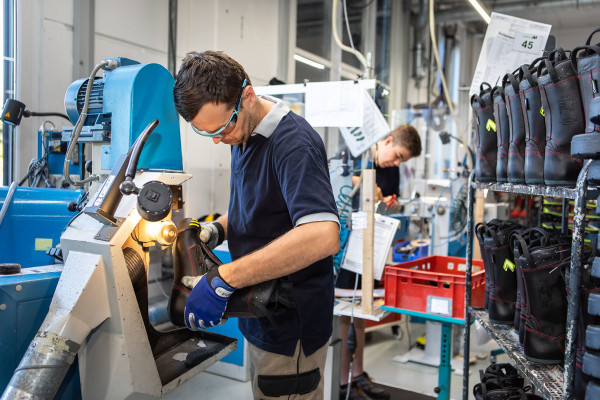From Concept to Fire Boot
Team development instead of quiet tinkering
As with every HAIX boot, the development of a firefighter boot requires real teamwork: a collaboration between artisan shoemakers, design experts and quality specialists in an intensive exchange across departments. And the boot can only meet HAIX's high standards when these collaborators work meticulously with the production, sales, and marketing teams as well.
Whether they’re in Germany, Austria, the US or Japan – HAIX boots are exposed to extreme situations every day. Design inspiration also comes from the wearers themselves, as their feedback flows into boot development via sales and marketing.
More than 25 years ago, HAIX celebrated its trade show debut at Interschutz 1994 in Hanover, Germany with its first, still very manageable, booth. Four employees presented the HAIX FIRE FIGHTER boot on a self-built exhibition area.
From specification to production
A so-called ‘requirements specification’ defines what the new boot development should be for, what the boot has to be able to do, which technical requirements have to be fulfilled, and much more. The concept for the boot builds upon this before ultimately being given an appealing design. At first, the developers start with simple hand drawings. This is then used to create a prototype – often it is initially only made up of individual parts such as the sole. The first prototypes are usually a mixture of literal shoemaking done by hand and computer-designed parts using CAD. They are put through their paces to see if all requirements are met, and improvements are made on an ongoing basis. After final approval, the first samples are produced, and then the final production of a new firefighter boot begins.
Highest requirements for fire boots
The codes and standards for firefighter boots, such as NFPA, places high demands on every component. The goal at HAIX is always to exceed these. Every component on a firefighter boot must survive five seconds of flame treatment without damage or burning. HAIX continuously tests materials in its own laboratory during the development phase. "This has the advantage that at the end of the development phase, we don't have to start from scratch again because one part hasn't passed the test," says Andreas Himmelreich, Head of Research & Development at HAIX. In the so-called ‘sand bath test’, the protective insulation inside the shoe is tested. A real endurance test: firefighter boots must be able to withstand 500°F for 20 minutes without the interior of the boot heating to more than 111°F. In an emergency, firefighters can usually be inside for up to 30 minutes until their breathing apparatus runs out of air.
When it comes to design, HAIX follows the philosophy of ‘nothing without function’ – which means every detail not only sets high standards visually, but also has a purpose. The additional yellow elements on the firefighter boots, for example, make fellow crew members more visible in smoky buildings.
The right firefighter boot for every scenario
Firefighters want boots that go beyond the standard’s requirements and are as comfortable as possible. After all, the PPE equipment can weigh over 90 pounds in use. Some scenarios require boots with additional cut protection. There is no universal ‘perfect firefighter boot’ (yet) – essentially, the boot has to be right for the individual wearer.
HAIX chief developer Andreas Himmelreich explains the basic differences: "Most firefighters prefer quick, simple slip-on boots. The lace/zip fastener system on our FIRE FLASH XTREME is still a popular request. Many firefighters are on the move so much that what counts most is a light weight, which is what the FIRE EAGLE AIR offers. And if you're looking for a sturdy boot that you can rely on in any scenario, our FIRE HERO XTREME is a good choice."
It can take at least two years, including test phases, to develop a new firefighter boot from the bottom up. Particularly innovative functional elements are sometimes worked on and optimized for even longer before they are ready for production.




